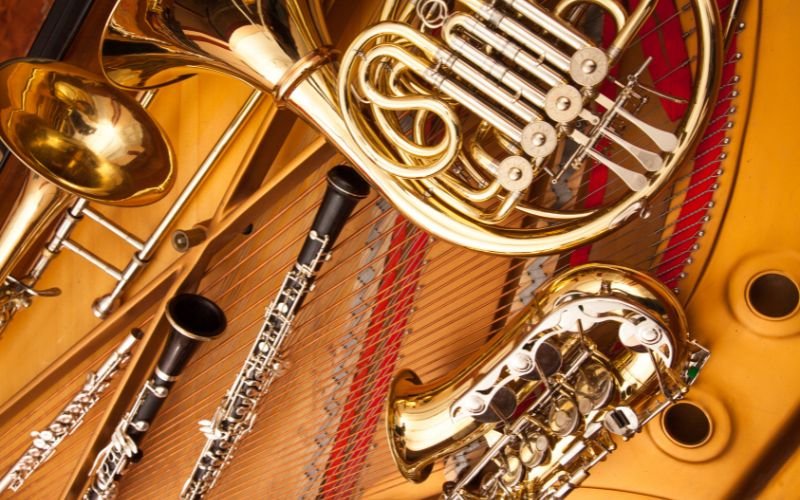10 instrument duos that go well together
How to combine instruments?
Playing a musical instrument is great. Uniting your instrument with another to create a beautiful musical harmony is even better. Are you looking for the ideal instrument to accompany your music on piano, violin, guitar or vocals? In a band or symphony orchestra, certain types of instrument work particularly well together.
Bingo! Here, Newzik sums up how to accompany your musical instrument. Zoom in on a list of 10 instrument duos that work perfectly together.
How do you combine instrument families?
Do you dream of forming a sultry duo like the famous rock band Oasis or the jazz band Louis Armstrong and Ella Fitzgerald? At first glance, creating a duo may seem like child's play, but in reality, it requires a lot of agreement.
In addition to the personal affinities between musicians, combining families of instruments requires an understanding of their sound characteristics and the way they complement each other. To achieve these sonic alliances, we need to take into account not only tessituras and timbres, but also musical genres.
💡 Learn more about the diversity of music.
Understanding the roles of instrument families
If you want to create a melodious association with your instrument, each instrument family plays a role in its own right when blended with others. An instrument family groups together musical instruments that share common characteristics, such as the way they produce sound, their material (wood, brass, etc.) and their role in a musical ensemble. These families are generally used to classify instruments in orchestras and bands.
There are three main instrument families: strings, winds and percussion. Each instrument family has its own specific functions, which can complement each other harmoniously:
String instruments (plucked, rubbed or struck) include the violin, viola, guitar, harp, mandolin, piano and voice. Versatile, the string family is often responsible for melodies (like the violin or viola), but also for harmonies (as in the case of the cello and double bass). In ensembles, strings add warmth and depth to sonorities.
🎙️ Whether soprano, tenor or alto, the flexibility of these voices makes them a perfect match for all instrumental families.
Woodwind and brass instruments
→ Woodwinds (flute, saxophone, clarinet): supple and expressive, woodwinds are particularly suited to fine melodies and dialogues between instruments.
→ Brass instruments (trumpet, tuba): powerful, brass instruments reinforce dramatic passages or accentuate the rythm.
Percussion (idiophones and membranophones): rhythmic and dynamic, they give structure and energy to tracks. Examples include drums and the djembe. Keyboards (piano, organ, harpsichord, celesta): harmonically rich, they can stand alone or accompany the other families.
Whatever your instrument's family, the important thing is to identify how it can be combined with another instrument according to its timbre and register.
📢 Want to test an instrument duet and listen to it again to fine-tune your performance? Record yourself and listen to your tracks using NewzikWeb's NewzikWeb recording function !
Harmonizing timbres
Harmony is the basis of musicalchord . To create harmony between instruments, their timbres must be complementary.
→ If you're looking for a soft timbre complementarity, you can combine woodwinds (clarinet, flute) and strings (violin, cello) for melodious, romantic pieces. For example, aflute and violin playing a duet in a high register can be supported by a piano for harmony.
→ And, to create a complementarity of powerful timbres, you could, for example, combine brass instruments (trumpet, horn) and percussion (timpani, drums), this could create a more dynamic piece.
🎧 Working on arranging a composition with several instruments? Discover our techniques for adapting musical compositions to an ensemble.
10 instrument duets that go particularly well together
Pairing instruments effectively therefore depends on understanding their sound characteristics and roles. Here's a list of essential duets with ideal sound combinations. Let's hear it!
1.Piano and violin
The piano provides a rich harmonic and rhythmic base, while the violin brings expressive melodic lines and a wide range of emotions. Their tessitura is therefore complementary. How do they complement each other? The piano covers the lows, while the violin dominates the highs.
🎵 Sonatas for piano and violin - Beethoven
2.Guitar and voice
The guitar, acoustic or electric, naturally accompanies the voice with its ability to play chords, arpeggios or light percussion. Folk, pop, blues or rock: if you want to launch a guitar-voice duo, you'll be spoilt for choice when it comes to musical aesthetics.
🎵 Mrs. Robinson - Simon & Garfunkel
"During the concerts I give, my voice is very often accompanied by an acoustic guitar. While I prefer the organic sound of the piano, the guitar gives me greater freedom in the interpretation of my compositions and covers. And, for the audience, the accompaniment of a guitar brings a special charm. It gives a very hushed feel."
Margaux Claudel, soul singer accompanied by a guitar during her live performances.
3.Harp and flute
The pairing of harp and flute produces the perfect sound to create a dreamlike ambience. The harp provides a delicate harmonic base, while the flute can express itself with airy melodies.
🎵 Syrinx - Debussy
4.Piano and clarinet
Combining piano and clarinet creates a rich dialogue between melody and harmony, ideal for creating nuanced pieces. In terms of aesthetics, these ensembles can be classical, jazz or contemporary.
🎵 "Preludes" for clarinet and piano - Gershwin
5. Voice and djembe
The djembe, with its percussive rhythms, is the perfect accompaniment to a voice, adding rhythmic energy and depth to vocal performances. This type of formation is common in traditional African song, gospel and folk music.
🎶 This duet can be found in traditional songs accompanied by percussion, as in West African music:
6. Drums and electric guitar
Between rhythmic riffs, melodies and solos, the electric guitar is particularly well supported by the energy and dynamics of the drums. Drums and electric guitar form an essential pair in rock, metal and blues.
🎶 "Seven Nation Army" - Jack White and Meg White in The White Stripes.
7. Violin and viola
From the same family of instruments, the violin and viola share a similar yet complementary sound. The violin shines in the treble, while the viola brings a richer, lower midrange. This duo brings harmonious, melodic dialogue to the compositions.
🎶 "Duet for violin and viola" - Mozart
🎻 Do you play violin in an orchestra? Facilitate exchanges with the other musicians in your ensemble by sharing your score annotations live! Record, annotate and share in just a few clicks thanks to the NewzikEnsemble cloud !
8. Themarimba and the flute
The warm tones of the marimba blend perfectly with the airy melodic lines of the flute. The duet is widely used in world music, but also lends itself to classical music.
🎶 Composition for flute and marimba - Ney Rosauro
🥁 Just starting to learn percussion? Find out our tips for getting started as an adult with advice from Victor Kraus !
9.Cello and acoustic guitar
Original, this kind of duet harmonizes very well. The cello adds warm, melodic depth. The guitar provides a rhythmic and harmonic base. This duo is particularly popular in modern chamber music, as well as in folk music. This atypical formation can be found in covers by the group 2Cellos, which mixes classical and pop.
🎶 Highay To Hell ft. Steve Vai - 2CELLOS
10. Piano and double bass
Often relegated to the background, the double bass anchors the compositions in deep bass tones. Alongside it, the piano develops complex harmonies and melodies. This musical pairing is quite common in jazz and certain classical pieces.
🎶 "How Deep Is The Ocean" - Charlie Haden and Keith Jarrett
Need help to improve your musical performance as a duo? Let the Newzik the Newzik application ! Start by loading your scores and synchronizing them with recordings to analyze the balance between two instruments. Then use the annotations function to adjust the phrasing and nuances of each instrument.







